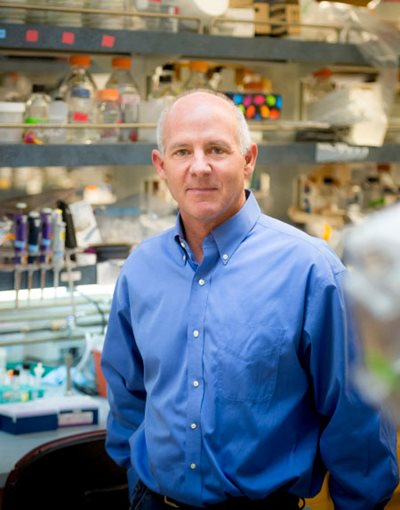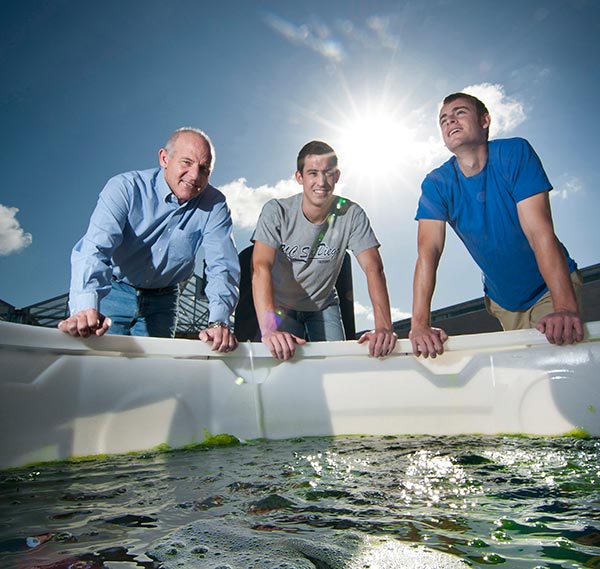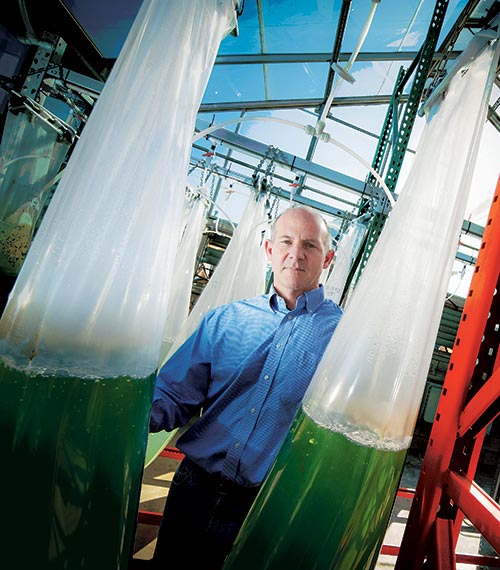31 October 2013
Algae-to-energy expert says fracking is fraud
By Henry Devries
 Here is a riddle UC San Diego professor Stephen Mayfield poses to his students. Why does a simple Google search reveal that the sixth brightest place at night in North America — right behind the well-lit mega cities of New York City, Los Angeles, Chicago, Dallas, and San Francisco — is the sparsely populated state of North Dakota?
Here is a riddle UC San Diego professor Stephen Mayfield poses to his students. Why does a simple Google search reveal that the sixth brightest place at night in North America — right behind the well-lit mega cities of New York City, Los Angeles, Chicago, Dallas, and San Francisco — is the sparsely populated state of North Dakota?
The answer is the methane burn off flaring from the myriad oil wells that fracking has brought to the state ranked 48th in population. To Mayfield, a professor of biology and director of the San Diego Center for Algae Biotechnology, fracking is a dirty word.
“As I tell people in my class when I show them the photo, this is the kind of addiction that is so crazy you need someone to come in to do an intervention,” says Mayfield.
Stephen Mayfield, UC San Diego professor
Hydraulic fracturing — now widely referred to in shorthand as “fracking” — uses water treated with chemicals to break apart rock formations. According to Richard Manning of Harpers Magazine, oil and gas have long been coaxed from fissures, gaps, and cracks in rocks. But fracking is simply a way to artificially induce more cracks (some of them more than a half mile long) by filling a bore hole with water, pressurizing it to as much as 8,000 pounds per square inch to split the rock, and forcing coarse material like sand and ceramic in to keep the new clefts open.
This isn’t wildcatting, says Manning, this is plumbing and it allows the wells to “produce for decades.” Mayfield disputes that point. In his mind, fracking is a “fraud” being foisted on the American public.
“This becomes fraud because fracking wells only last three years, not twenty years,” says Mayfield. “Unlike a traditional well, where you drill a hole down and hit a big pool of oil that is in saturated rock, fracking wells work what is called tight oil because it is not free flowing.”
Mayfield’s concern is that while a record $186 billion a year is being invested in oil exploration, about half of one percent of that is now being invested in renewable energy. From a peak of $7 billion a year, renewable energy investment is down to $1 billion. Yet he still hopes algae will one day be the fuel that powers U.S. automobiles.

"That's what petroleum is — it's ancient algae," says Mayfield, "Algae already makes oil that looks like crude oil. The oil we extract from algae goes directly into a refinery and gets converted into diesel or gasoline.”
The research in the Mayfield lab focuses on molecular genetics in green algae, and on the production of therapeutic proteins and biofuel molecules using algae as a production platform. Engineering algae for the production of hydrocarbon molecules that can be used as biofuels is a major focus of the lab, and recent studies have demonstrated the tremendous potential of eukaryotic algae for the expression of recombinant enzymes that allow for greater production of biofuels.
Thanks to an innovative program led by Mayfield, in partnership with UC San Diego Extension, workers are being retrained for the new green economy. Many have received their certification to work as general science technicians in the rapidly expanding biofuels industry in San Diego County and Imperial County.
“Nationwide there is a need for skilled workers to participate in the development and commercialization of new technologies, as we can see in the field of alternative energies,” said Hugo Villar, director of science and technology at UC San Diego Extension. “The university has been a leader in helping adult learners acquire new knowledge and skills that allow them to transition out of stagnant areas of the job market and participate in more vibrant areas as we are doing now with biofuels.”
Mayfield also sees algae as a food source for livestock, helping to solve the world’s emerging crisis in food production to feed a hungry world.
“We have to get more efficient at producing our food and more efficient at utilizing energy to produce our food,” adds Mayfield, who believes the problems of the Arab Spring were related to food shortages. “We need to get more efficient not just for America, but for the seven billion people who live on the planet. There will be enormous chaos in the world if we allow energy to go to $140 a barrel, corn to be $10 a bushel and wheat to be $14 a bushel. I think science gives us the potential to become enormously more efficient.”

As the biofuels industry continues to develop and mature, there will be an increasing demand for a well-trained workforce, including research and development scientists, engineers, and field technicians, through to policy  analysts, business development professionals and project managers. Training will also be required by the support industries, which will no doubt be springing up as the biofuels industry grows.
analysts, business development professionals and project managers. Training will also be required by the support industries, which will no doubt be springing up as the biofuels industry grows.
Undergraduates and the general public now have the opportunity to take one of two Biofuels Certificates offered by UC San Diego Extension, Biofuels Science and Biofuels Processes.